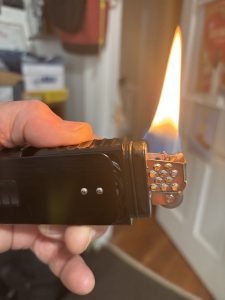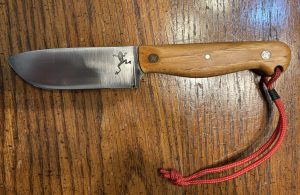
TU ON THE RIO GRANDE
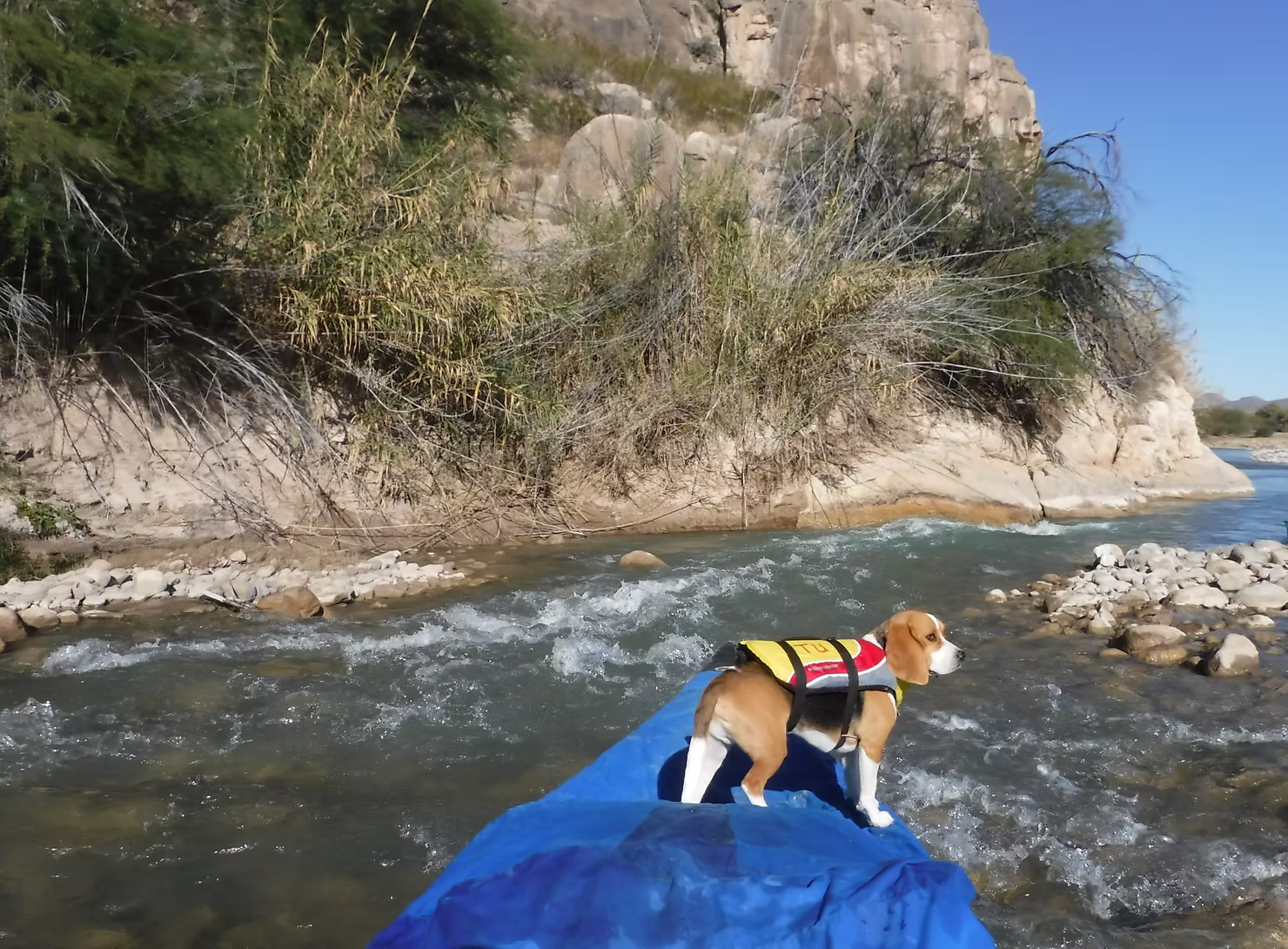
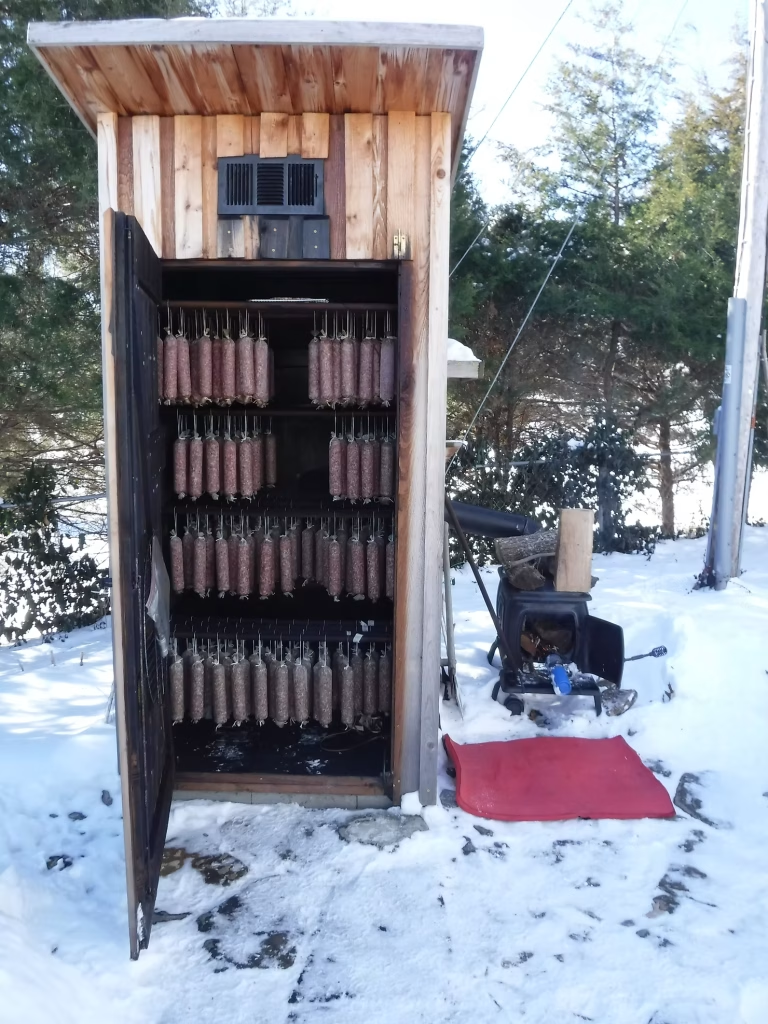
This guest blog, by, Tony Heck, is a great read. It’s long, but worth your time.
About Tony: Tony is a jack-of-all trades outdoorsman, paddler and master sausage maker. He travels with his little Beagle dog, Tu. Tu has grown quite comfortable sitting atop Tony’s specially outfitted Old Town Tripper canoe. Tu never complains.
Tony’s home-smoked sausage is my go-to lunch meat on canoe trips. It keeps fine for the longest trip and is much tastier than what I’ve found in stores. Contact Tony for product and prices.
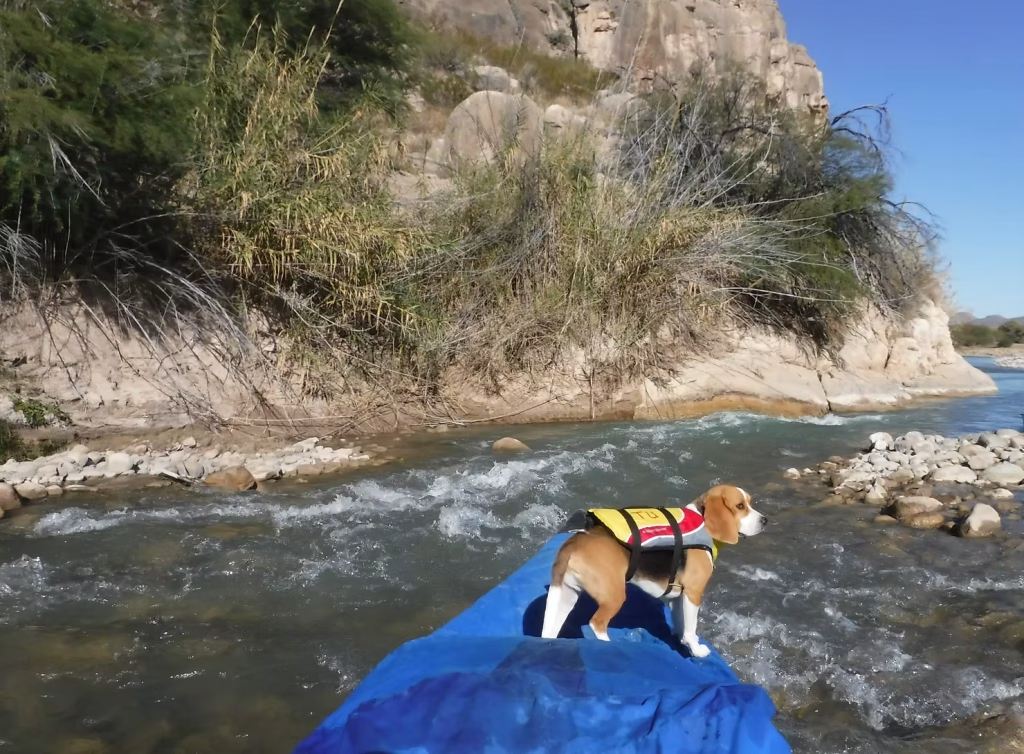
Tu is pretty cavalier about this… Boquillas Canyon (December 2023)
Tu and I return to a place that has captivated us since our first visit a year ago, the high desert of the Chihuahuan region of southwest Texas. From the viewpoint of a mid-westerner, the stark landscape of the desert seems so barren and a bit scary (rightfully so). However, there is an incredible amount of beauty. From small yellow desert flowers to the nearly 8,000-foot-high Emory Peak, there are things to catch your eye and your imagination.
This trip centers on the 4th longest river in the United States, the Rio Grande.
In particular, Boquillas (bo-key-us) Canyon is our goal. The canyon is named after the small Mexican Village of Boquillas del Carmen, located near the canyon’s western entry.
Boquillas del Carmen was founded upon silver mining, which played out in the early 1900’s. Now, the tiny town relies on Big Bend National Park for its economics. There is no international bridge here, just a Mexican with a johnboat below the Border Patrol office. For two dollars, you can get shuttled across the river (if you have a passport/visa), and a few bucks more buys you a mile long donkey ride into the village. I’ve heard the food there is very good. The locals make crafts, and illegally cross over to the National Park’s Boquillas Canyon trail and set their wares out for sale on the honor system. The US authorities don’t like this but turn a blind eye to the system.
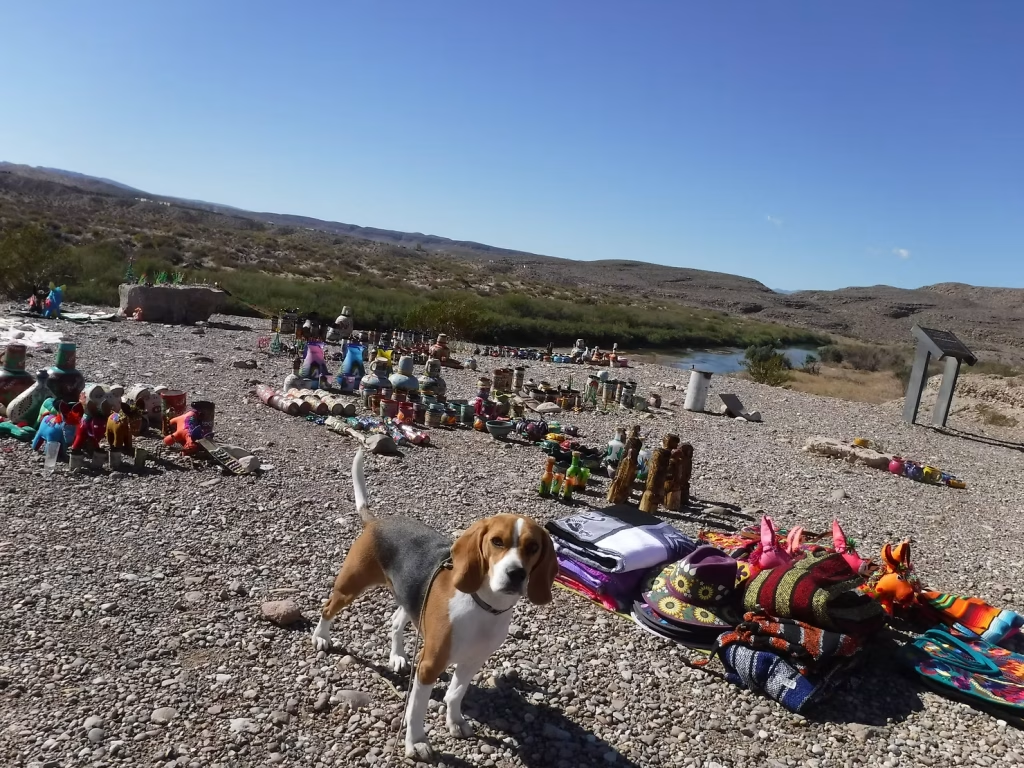
Tu wanted toys; I bought some twisted-wire art, a road runner (we’ve seen several)
and an Ocotillo cactus.
Boquillas Canyon is the deepest and longest canyon in Big Bend National Park; it’s significantly deeper than the Grand Canyon, having 7,000 feet of relief from nearby Pico del Carmen of the Sierra Madre mountains.
While Boquillas Canyon is the easiest of Big Bend’s canyons, it is narrow, twisty, and tricky at many places. There are three locations where high-level caution is needed, but these were not the locations that capsized two canoes, where Tu and I came to the rescue of four people (more on that later).
Our trip will last four days, and we’ll travel 33 miles from our put-in at Rio Grande Village (the old US side of Boquillas del Carmen), down a little past the Mexican town of La Linda and the closed Gerstaker Bridge, to a private take out at Heath Canyon Ranch. Water Level: The river is low now, a crazy-low of 38 cubic feet per second! Paddlers generally agree that 100 cfs is about the minimum for a float-friendly trip. Two outfitters and the National Parks Service tell me this is a “doable” level but I’ll need to drag my canoe some. My post-trip take is that 100 cfs is the minimum for a loaded canoe.
We arrived in our favorite Texas town of Study Butte (Stoody Byoot) and get a campsite at Rancho Topanga, a few miles west of the ghost town of Terlingua, then head back into the ghost town for an evening of wine, conversation, the Starlight Theater, and “The Porch”, which, for decades, has been a local gathering place for locals to meet. The mix of people here ranges widely, from the rich and famous, to hayseeds from Missouri. Everyone here is nice, or “tolerating” if we are talking about the patched one percent Banditos biker we met (this fellow’s stare would make Clint Eastwood’s blood drop a degree). For a ghost town with nothing going on, it sure has a lot going for it. Perhaps its the warmth of the people which offsets the stark and austere desert, making the conversations and stories even more enjoyable. Too much wine before dinner, so I skip the antelope steak, and just get a cheeseburger.
It was a cold night, with the desert air somehow leaving a layer of heavy frost on things. As soon as the sun breeches the horizon, the temperature rises, the frost leaves, and before you know it, it’s 45 degrees and time to start moving.
Its a two-hour drive across the National Park to Heath Canyon Ranch–our take-out. But before we get there, I need permits from the National Park to access the river, and to back-country camp for several nights. Soooooo…. a bit of back-story is needed here: Last year, the Muskogee County Sheriff and I were talking out front of a convenience store:
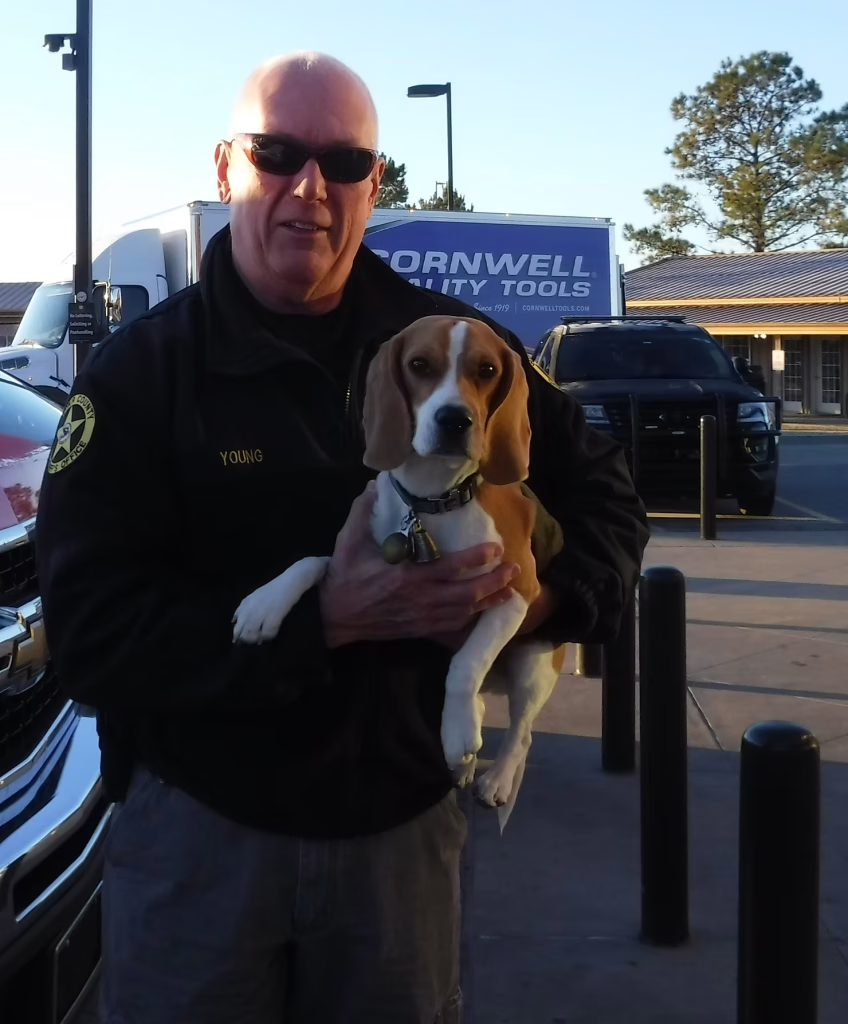
The conversation went something like this:
Hi, would you mind holding my puppy so I can get a picture?
Officer: Sure, he looks like a real outlaw.
Me: Well, now that you mention it, we are amateur outlaws; we’re in it for the fun, not the money.
Officer, laughing: No major crimes?
Me: Nothing major; but Tu has just never seen a leash law he likes.
Now, back to the permitting process….at Panther Junction I park far away from the office, so Tu will be out of sight, as dogs are NOT allowed on the river. The National Park Service Ranger has me follow along with the rules as he reads them to me: Extra PFD? Check; Extra Paddle? Check; Waste System/wag-bags? Check; Fire-pan? Check; Safe Load? Check; No Pets? Check. (ya, amateur outlaws)
Permit in hand, I roll down the car window as we leave the parking lot and sing a bit of Johnny Cash’s song “Rock island line”, about a train conductor dodging a toll for having materials and not livestock on his train:
“If you got certain things on board when you go through the tollgate
Well, you don’t have to pay the man no toll
Well, a train driver he pulled up to the tollgate
And a man hollered and asked him what all he had on board and said
I got livestock,
I got livestock,
I got cows,
I got pigs,
I got sheep,
I got mules.
I got all live stock.
“Well, he said, “You alright boy. You don’t have to pay no toll
You can just go right on through, ” so, he went on through the tollgate
And as he went through, he started pickin’ up a little bit of speed
Pickin’ up a little bit of steam
He got on through, he turned and looked back at the man, he said
Well, I fooled you I fooled you! I got (pig iron) a beagle! I got (pig iron) a beagle!! I got a pig iron beagle!
To be up front, a friend told me he was paddling this stretch, and an off-duty Ranger had her dog with her as she paddled Boquillas Canyon. She said “Please, don’t tell anyone about my dog.”, and my friend replied: “Sure, as long as you won’t tell that we’re not packing wag-bags .”
Going to Heath Canyon, we parallel Black Gap Wildlife Management Area, where they are trying to eradicate the invasive Auadad sheep and reintroduce bighorn sheep. NPS sharpshooters have shot 175 of these Auadads last year via helicopter. At Heath Canyon Ranch, we meet Adrian the mother of Russel and Colt, and she told me how she got to this extremely remote place (three hours drive to any town). Back in the 80’s, Dow Chemical built the one-lane Gerstaker bridge, and a processing plant on the Mexican side to support their new flourospar mine. Adrian’s father was an Engineer for Dow, and when Dow closed the plant, her father bought the airstrip (used by Dow), and the adjacent Plant Manger’s home, outbuildings and a big chunk of desert land. Adrian and her son, Russell, operate a river guide service now, and we camp near the top of the old runway for the night, in preparation of our put-on the following morning.
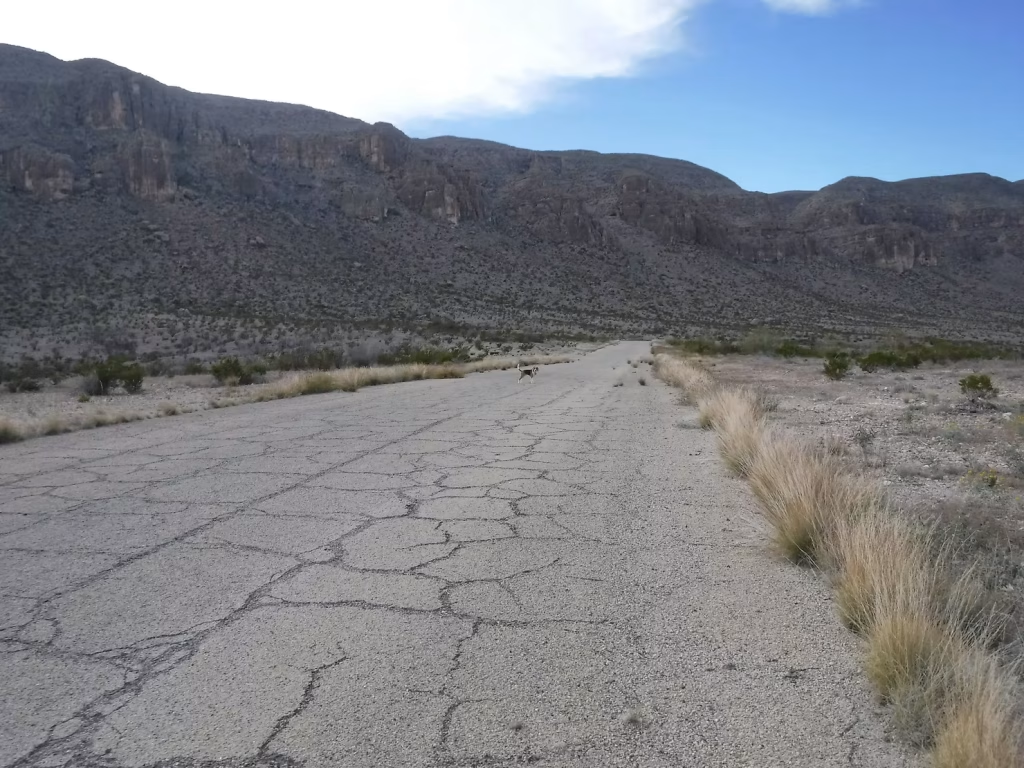
Tu explores the old runway, finds an old tennis ball, and we spend time playing fetch.
I’ve noticed that at the beginning and during these long river trips, Tu gains weight, and I lose weight. I think it’s a combination of the altitude gain (going from 560 feet above sea level to about 4,000 feet), and the general nervousness of a long solo trip in unknown territory. Despite watching every Youtube video I could find of this area, and finally getting better maps, I can’t shake what I’ve read about the Grand Canyon, and how side-canyons create some crazy whitewater and rapids. Like the Colorado River, the Rio Grande is a pool & drop river, and the same rules apply. I have my much-loved and trusted Old Town Tripper canoe, a 17’-2” piece of floating artwork, and my spray cover for it. Tu has been atop my canoes since he was just a few weeks old and has great sea-legs. This instills confidence, but it doesn’t take much to get killed out here, or any remote place.
A few years ago, a fund-raising canoeist on the Mississippi River cut his foot on a sharp rock; after a few days, his foot was starting to get infected, and his concern grew. His concern was such that he did not notice the wind direction and water currents as he pulled into Wickliffe Mounds State Park’s boat ramp. After finding no help, due to the closed office, he hobbled back to his canoe. Had he not been distracted by his predicament, he would have seen the wind was strong from the west, that he was on the outside of the river-bend, and a raft of barges was moored below the ramp, a few hundred yards away. The wind and current prevented him from clearing the barges, and for probably two minutes, the horror of impending drowning dawned on him as he desperately tried to escape. He was pushed underneath the moored barges and died there.
There are so many stories of outdoor related accidents, many having deadly outcomes, and most due to lack of knowledge, lack of experience, and/or lack of proper gear and/or gear storage. Well get back to this topic shortly.
Tu, Adrian and I arrive at our put-in, Rio Grande Village about 11:30 am, and we are on the river at noon. As we pull away from shore, a Mexican horse-rider crosses to the US side, to fill some water jugs.

We are in luck, as a recent rain caused the river to rise to 100CFS last night, but it dropped to 68CFS at the time of our launch. I know there are springs in the canyon, so we should have a decent float, but immediately after getting the canoe to river center, we hit rocks, then more rocks. Rats. Gotta get out and drag the canoe, a frequent activity for the next five miles or so. The river is flowing at about one mph, and it takes us three hours to get to the mouth of the canyon. The entry of the canyon is narrow and hard to see until you get right near it.
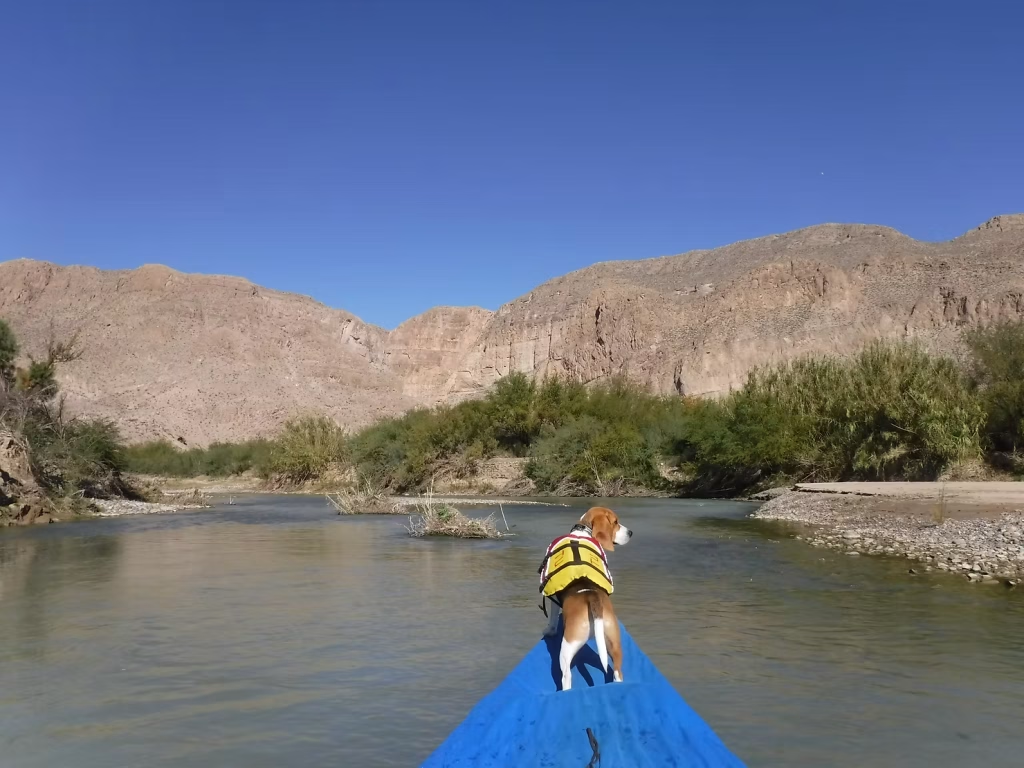
We are pointed right at the canyon mouth, but its very hard to make out.
The NPS Ranger, in charge of river permits, told me that I was the only person going through the canyon this week; I was not sure if that was good, or bad, as I just can’t shake the feeling that something bad is going to happen. I try to utilize this feeling for the better, and try to make every movement in a deliberate manner and concentrate on my paddling technique, for improved efficiency and safety.
We get close to the NPS beach at Rio Grande Village, and hope to pass by unseen, as all it might take to stop/ruin this trip is a tourist seeing us and reporting a dog to a Ranger. I sweat a bit in the cool, dry desert air as I see a family up ahead on the beach. A small boy shouts “Ola!”, as we approach. I do my best Spanish with “Ola, mi amogo! Como estas?”
For a moment, I have them fooled, and the boy says, in good king’s English, “I am trying to learn Spanish.” I answer: “Well, you know as much or more than I do.” and we all laugh. In another minute, we are out of sight around a bend. GOOD DEAL, now we just need to get past the hikers along the short trail that goes into the canyon. I am not worried about the Border Patrol, who overlook the river just below us, as they are not looking for canoeists, but border crossers. But there is a risk that an NPS worker might be at the Border Patrol office and see us. But no problem: we successfully pass by then close on the canyon mouth before us, at 2pm, three hours from put-on.

This is where it gets interesting.
We see some hikers on the USA side, but we’ll be long gone before anyone can report us. That nagging feeling of “something bad is going to happen” just can’t be shaken. Something is up, and its bothering me–it’s bad “beta” as the Adventure Folks call it.
The Rangers voice pops into my ears…”You are the only one out here this week!”
What was that? Tu, did you hear that? Where is it coming from? Ah, I see; we are not alone. Up ahead I see two outfitter canoes, each having two paddlers. We get closer and see something that makes me scowl: disorganization. Seems these folks are very new to paddling. As we pull near the canoes, we say hello to Addie, a pretty young lady, maybe in her late 20’s, Elon, her stern paddler, and Ezra and Anthony in the other canoe. All are about 30 years old, from New Orleans, very friendly and laid-back.
We chat for a moment; determine we are all going on the same trip and timeline. Elon and Addie’s canoe is about to run into me, so I show Addie how to make a bow-draw paddle-stroke to avoid the impact.
Addie does the maneuver and their canoe swings away from us. I tell her to remember that paddle-stroke, as it will come in handy. We say our “see ya laters’s”, as Tu and I continue down river. We drag a few more times, and I become worried that the frequent dragging will slow us enough to make us late to the takeout.
At 3 PM, it is 60 degrees in the sun. It drops 10 degrees in the deep shade of the canyon. Up ahead, on the US side, the river makes a sharp left-turn and rushes into a brushy vertical bank. Tu ducks as I draw, and we enter/pivot/swing as needed to avoid the cut-bank. Looking downstream about 200 yards I see the first of many great campsites to follow– a stepped gravel bar on the Mexican side at about the 802.7 mile mark. It’s still early, but this campsite is too nice to pass, so we stop for the day.
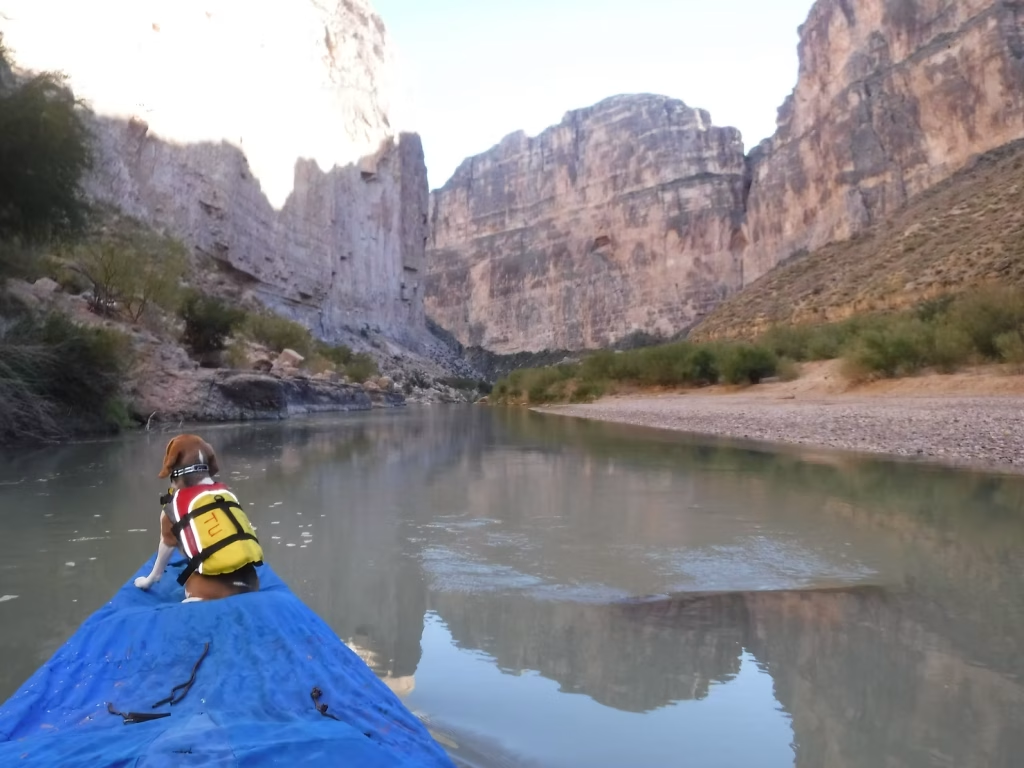
A nice campsite, camp #1, on the Mexican side.
Due to the settling sun, it’s getting colder (it’s now 45 degrees), I set up camp, as Tu explores. That nagging feeling of uneasiness is still present, but I tell myself it will be gone tomorrow.
Hey! What’s that I hear? Looking upriver, I see the two canoes come around the bend. Suddenly, I hear a scream.
OH, SHIT!!!
I jerk my head around to see the first canoe being swept into the brushy cut-bank, two swimmers and gear floating in the water. Seconds later, the second canoe follows suit! It hits the cut bank and rolls, throwing two men and their gear into the river!
Fortunately, no one is pinned–they are just swimming in open water. GOOD! I holler: “Get your boats and gear and come here; I’ll start a fire!” I quickly throw down my fire-pan, fill it with charcoal, douse the briquettes with fluid, light it, then do a search for wood. I keep an eye on the paddlers, as I search. Soon, I have enough wood for a small fire.
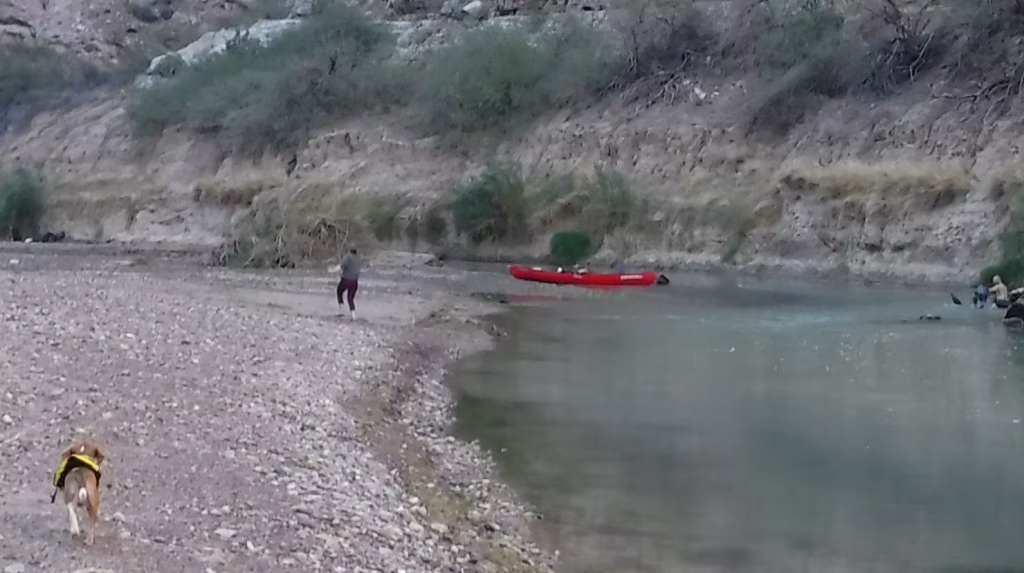
Tu runs to the aid of TWO capsized canoes (red one and a green one at the left of the frame).
I scrounge for more wood while the wet paddlers gather their boats and gear. Soon, our new friends gather around the fire, crowding Tu and I out, but we are dry, and they are not, so we don’t mind. Something is unusual about these folks, and I can’t quite put my finger on it. They seem almost happy about the dunking and are not “moving and grooving” to get themselves dry or check their gear.
Its now 4:30pm, and the sun is completely out of the canyon, and its getting cold, about 40 degrees.
From experience, I know they are burning a huge amount of energy, and that soon their body temps will drop, fingers get stiff and mental dullness comes into play, which affects decision making. Hypothermia is a real concern. After mildly suggesting they get into dry clothing several times, with no result, someone mentions why they seem so unconcerned.
The young lady says: “Considering we capsized and got all wet, we are fine due to the Adderall and THC gummies we’ve had.”
Hmmm…I give each one a swig of dry red wine, and politely order them to get into dry clothing. “Right now!” I tell them to eat something fatty (nuts, lunch-meat, anything with a high fat content, to keep their internal ‘fire” going). They comply and then realize how cold they really were, and how cold the night will become (we’ve had heavy frost every morning).
While they change clothing, I consolidate the fire, add more wood, and dig into my cooler. Soon, they are huddled around the fire, drying off damp clothing, and it becomes apparent that they know nothing about building or maintaining a campfire. I have to shoo them away every five minutes or so, to add sticks, or re-lay the bundles of twigs they lop onto the fire, depriving the fire of oxygen. After a while, to my astonishment, they bring their tents to the fire to dry them out.
“Hold on, Hoss, you are going to burn your tent; go set your tent up and it’ll be dry soon.”
This they do, then return with their air-mattresses. I refrain from a lecture on leaving drugs at home when canoeing, that gear should be protected inside dry-bags. Yes, they did have dry bags! All empty and unused! They had brought firewood too, about six sticks small splittings of hickory, most of which floated away. A Bic lighter was all they had to start a fire. I doubt they’d have been able to get a fire going, considering the mental dullness brought on by the Adderall and THC gummies.
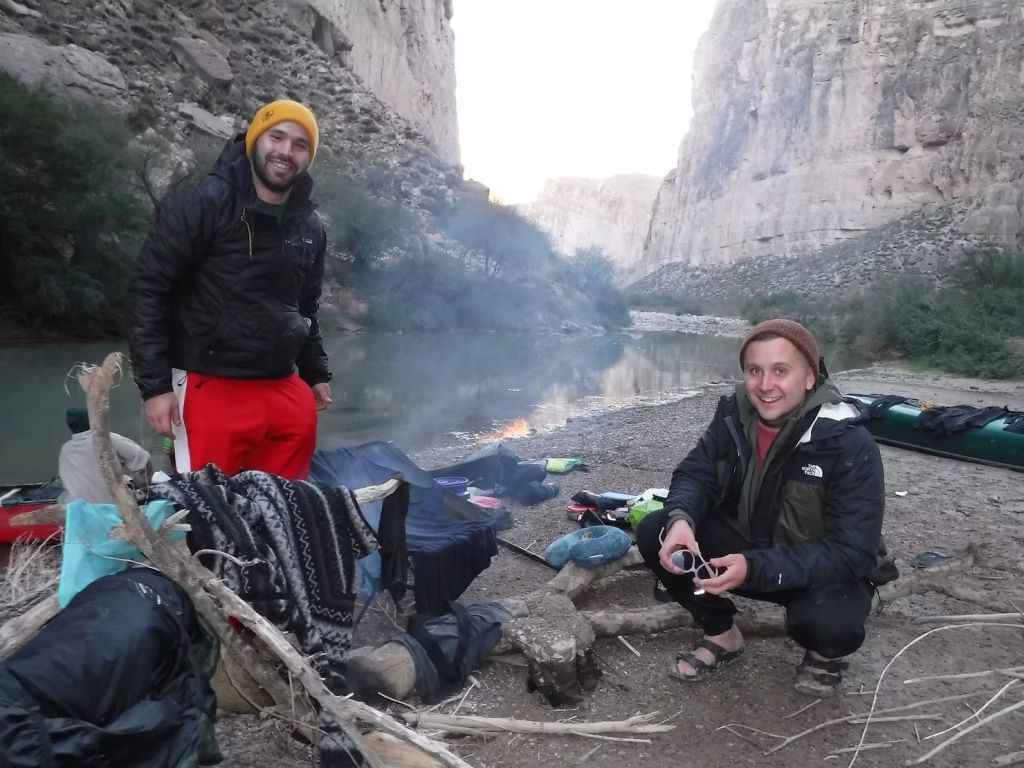
The fire is hidden from view. At least they are now dry….
While drinking my wine and writing in my journal, I ask if they have a two-burner stove. They do, and a skillet, so I ask them to bring me their stove and skillet. I’d brought out a 1.5 pound piece of very meaty bacon I had cured/smoked in preparation of this trip and fried that up for them. I knew this bacon would stick with them, and provide warmth. Boy, did they like that bacon! They also heated up some canned soup, and with that, they stayed warm, despite their semi-damp clothing. Luckily, their sleeping bags, which had been sealed inside plastic trash bags, were reasonably dry.
I fed Tu some pre-cooked beefalo burgers (I’d brought 16 pre-cooked and vac-packed quarter-pound burgers), two raw beefalo rib-bones and half-a-can of dog-chow. After he wolfed them down, he gives me that look that says, bed, please. Then he goes into the tent and sleeping bag for the night. My nerves, or whatever, told my appetite to take a hike. Red wine is my dinner. I will pay for this tomorrow (and do).
The following morning, we all break camp at the same time, but our companions linger around the remains of a still burning log. I admonish them to be SURE the fire is dead out when they leave. Tu and I depart, after giving them a look at the maps (they lost their maps in the flip) and show them where I’ll try to camp (a large flat, which should receive early morning sunshine), about ten miles down river, at the 792.25 mile mark. I offer this for their peace of mind, and wonder if they will camp with us again. Solo is what I came for, but these are nice and friendly people, but I feel concerned for them, as we’ve not hit any difficult water, and there are three rapids up ahead, which the maps caution about.
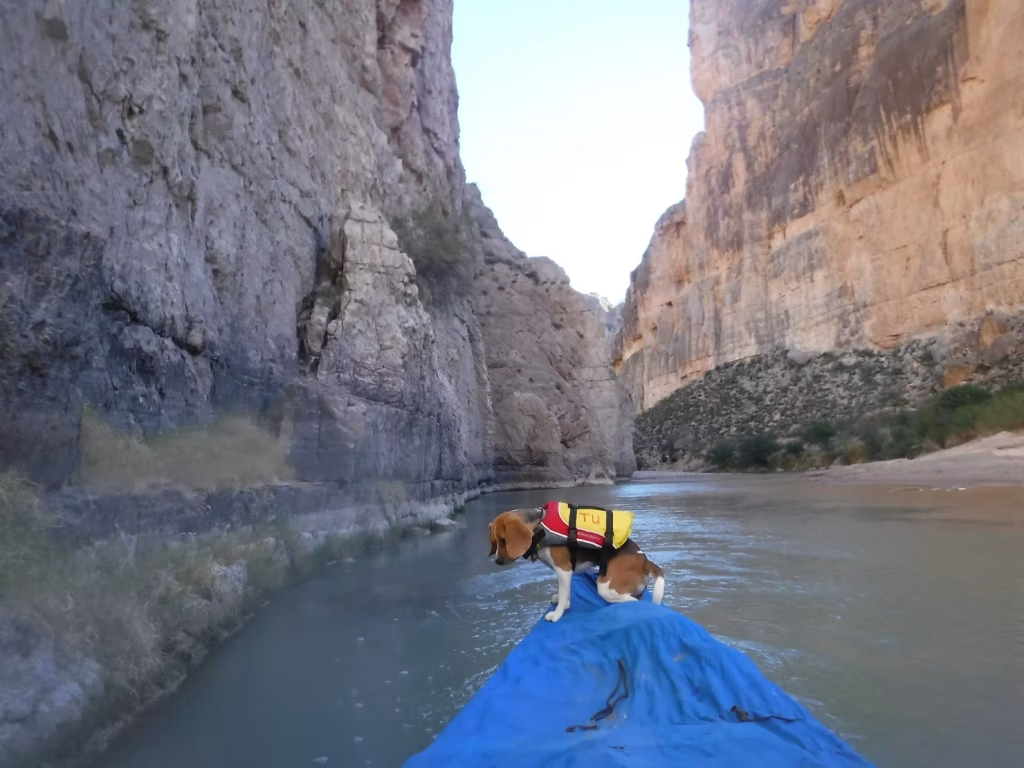
Tu looks at the deep swirling water as we leave camp #1
We have a pretty easy day on the river, dragging the canoe occasionally, but not as much as the previous day. The steep, vertical walls keep me captivated, as do the occasional horse/donkey/mule we see. (One walked near our camp last evening, before full-dark, and Tu was very interested, but stayed-put at my request.) As we round a bend and get into a shallow straight away, we see three Mexican Vaquero’s cross from the Mexican side over to the US side of the river. They have saddle bags and bedrolls, but they are traveling light. What a thrill to see real cowboys! While they are only 75 yards away from us, they ignore Tu and I. It makes me wonder what they are doing.
At the 794.5 mile mark, we come to the first of the rapids shown on the map, Arroyo Venado Rapid. The RDB (Right Bank Descending) canyon wall is close and vertical, and at the base is a rock-pile of small-car sized boulders that we have to pick our way through. Luckily, at this low/slow water level, no issues. At higher water, this would need to be scouted.
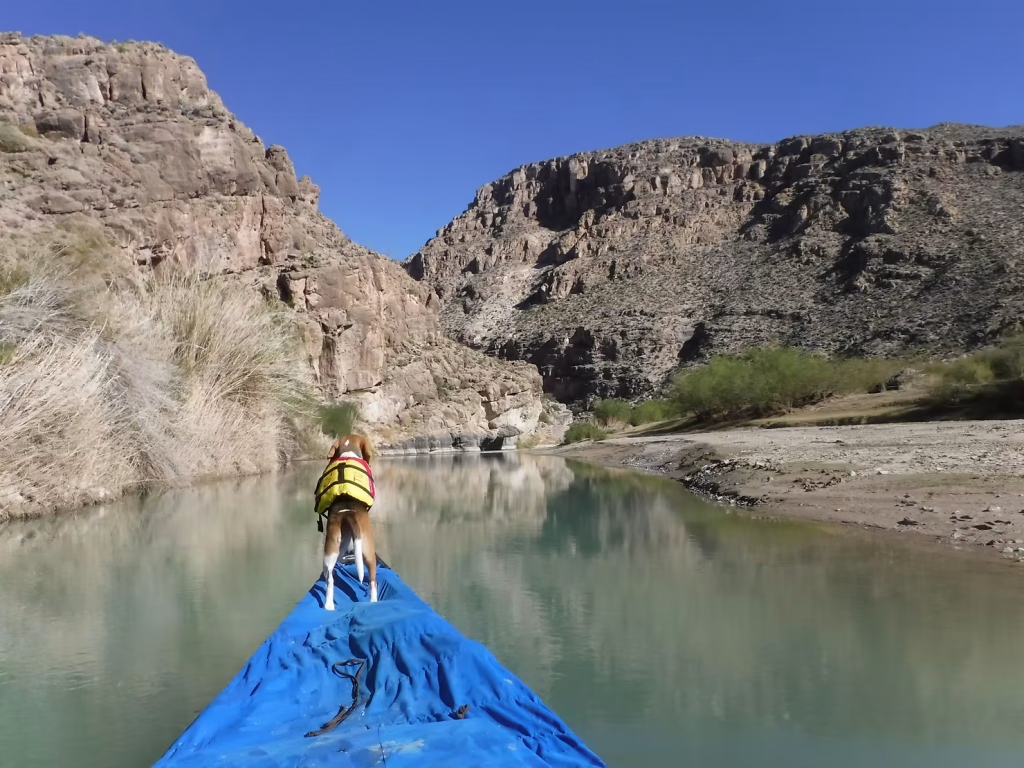
Tu on point, as we approach campsite #2, a large grassy flat–an ancient campsite it turns out.
We travel ten miles today, which is needed, due to the time/distance factor, and need of not being late to the take-out, which would alarm our Outfitter as well as the NPS Rangers. Our campsite is fantastic, and despite an early arrival, we stop here for the rest of the afternoon. After setting up camp, and gathering firewood, we explore this large flat of land. Downstream, we find several old empty tin cans in the shade of a large bush, and Tu finds the remains of a desert whitetail, and takes a roll. At least they were as dry as English humor, and he didn’t require a bath. Our upstream walk has my “spidey sense” telling me there has to be a concealed camp, somewhere along this flat, and after a search, we find it. Tucked against a cliff-wall, and underneath a medium sized tree, we find a small, elevated flat, room to tether a horse, lay a bedroll and make a small fire. The smoke marks indicate ancient use, but the tin cans, rusted metal/enamel bowls full of detritus and fire-pan say this has been used in modern times, but not in a long time.

Old rusted bowls and a skillet locate an old campsite, perfect to hide from the desert sun.
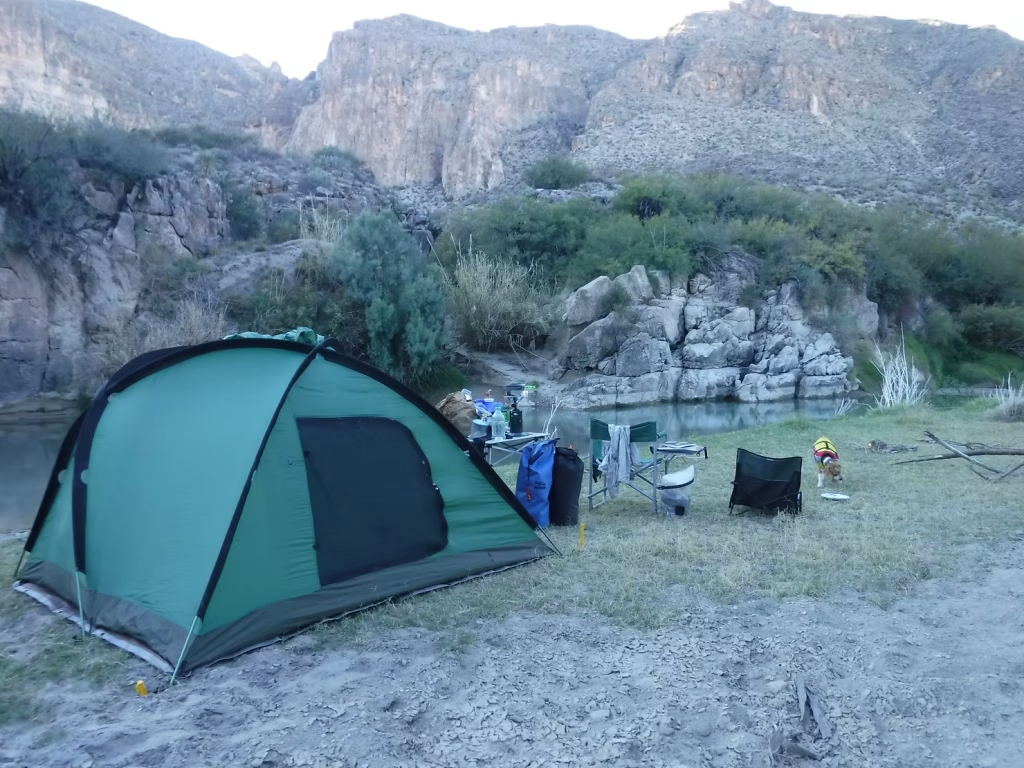
Our camp
I expect our new friends to join us, but they stop short of our camp. I wonder where they camped, as this was the first good site I’d seen in several miles.
During our walk around, a raven flies down from a cliff-face and comes close to us as it flies by. I give it a soft/friendly “kaw”, as the raven circles me at about 15 feet away. He’s so close that I can see his eyes watching me closely. I give soft gutteral crow sounds, and he circles again, then lands on a perch overlooking us. After a moment, another tight circle around me and off he flies, up the canyon. Neat!
The next morning, as I was drinking coffee and writing in my journal, the two canoes come around the bend, and stop to say hello. I give them a look at the map, which shows no major obstacles in the next ten miles, which should make for a good day for all.
The river has dropped about six inches, which makes a concentrated channel all that much smaller. The lines in the river here are generally four inches wide “must make”, as if the canoe gets off that line by half a foot or so, I’ll have to drag the canoe. Many times I need to get the canoe on its side, to squeeze through the shallows.
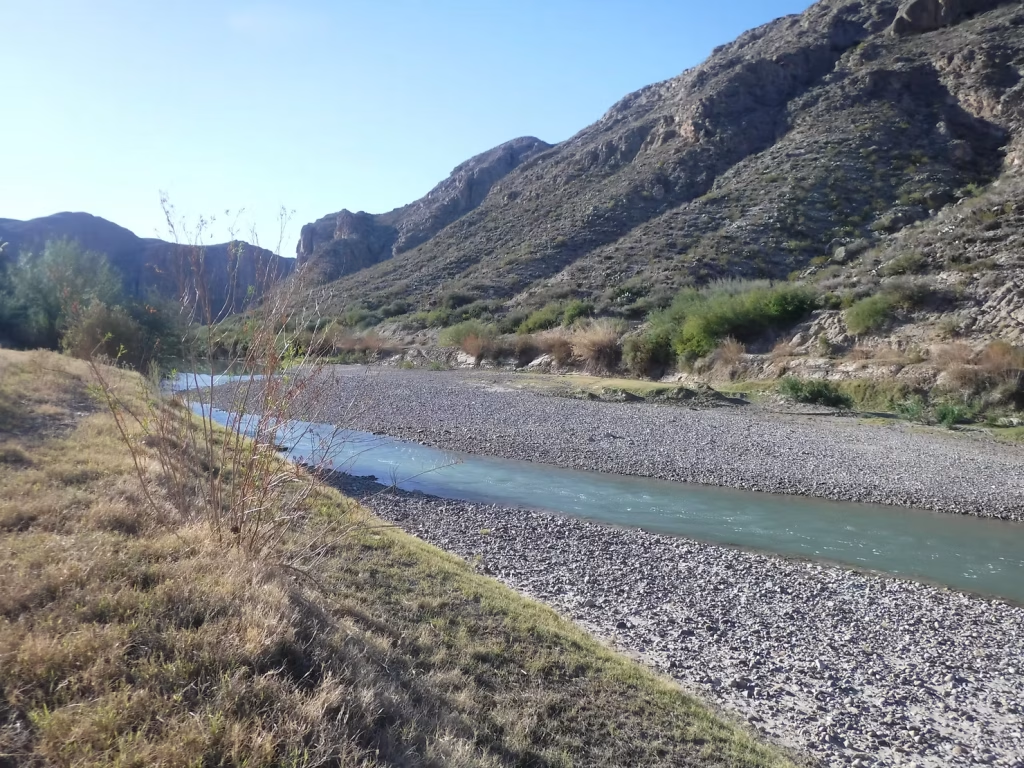
The Rio Grande gets very narrow in low water conditions.
We pass through the single-most scenic river-way I’ve ever seen, which includes Glacier N.P., Yellowstone N.P. and many other scenic rivers. The water is clearing up after the recent rain, and the aqua-green color is returning. Remember those Vaqueros? At the end of a long pool, the river makes a sharp left turn into a small rapid. As we approach the “catch” at the top of the drop, a small herd of horses and cattle come up to RBD and stop when they see us. I stall, wondering if I should proceed before the herd, or wait for them to cross. Its an easy decision, as I hear a vaquero’s voice behind the herd, and they jump into the water, as I back-paddle with deep, powerful strokes. This was the 5th time I was almost stampeded by cattle! (Twice on Missouri’s Gasconade river, and twice on the Little St. Francis river by 4×4 mounted herdsmen).
After the main group of cattle and horses pass by, the vaquero sees us and apologizes. I say “No need to apologize; I should thank you; May I take your picture?”, “Si” was the reply.
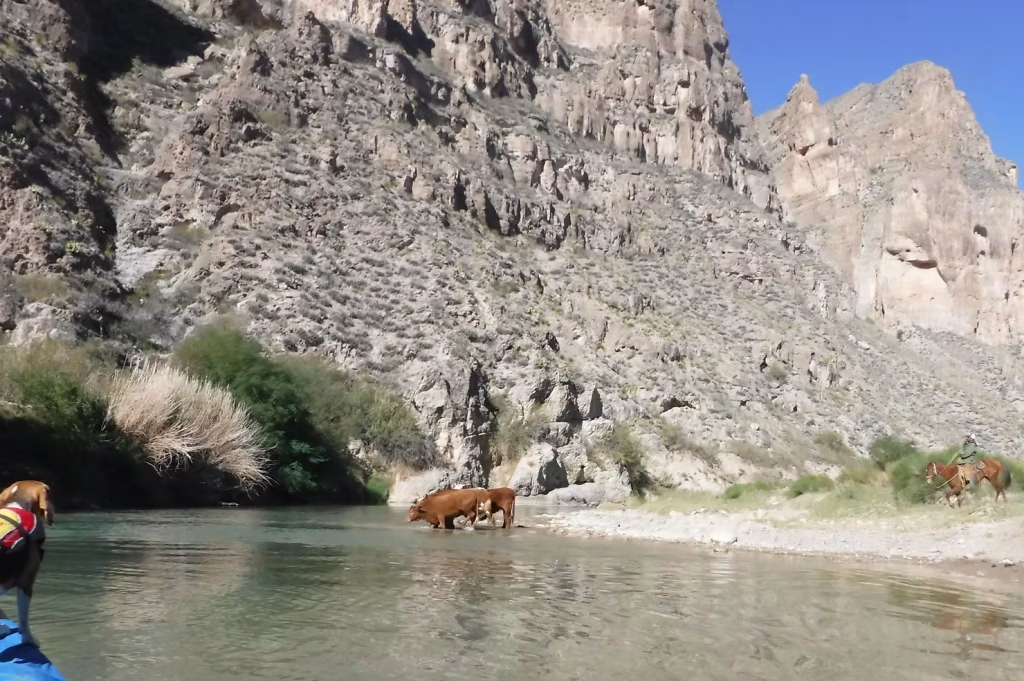
This is the second group getting ready to cross, I was too slow to get the main group.
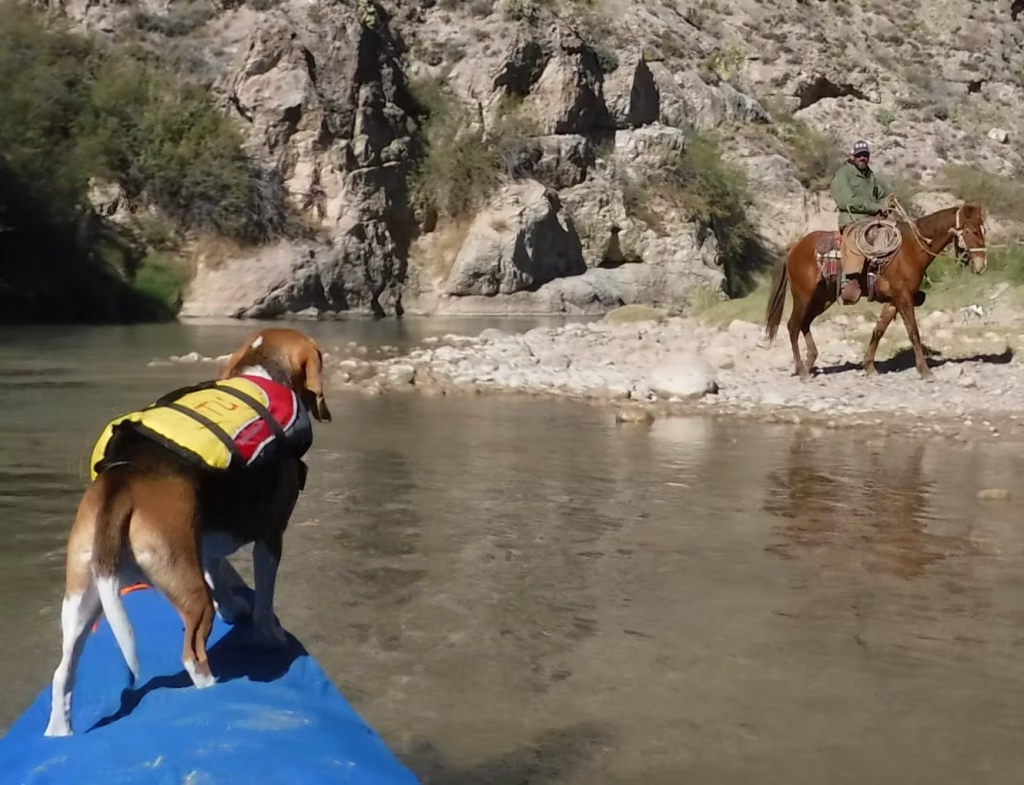
One of the Vaqueros we saw the day before, near the west side of the canyon;
we are now nearing the east end.
In broken English, William tells me he has been out rounding up cattle and horses since yesterday and has not eaten anything since yesterday. He asks if I have anything to share, and after looking at my covered canoe, and the buried cooler, then the fast water we are almost into, I remember that my breakfast–three granola bars– is in my PFD pocket.
I dig the granola bars out and start to approach him and his cattle dog when Tu stands quickly: the hair on his spine stands straight up as he gives a mighty puppy “Ruff!” The “Ruff!” was so small and cute I almost laughed. We got the message, so I motion to William that I will toss the granola bars onto the rocky shore, and he nods. I do, then peel-out into the rapid.
He gets the granola, thanks me, then he crosses the river, while his dog whines and watches. After a moment, the dog crosses too. I then watch the remaining two vaqueros come up the trail, as we disappear around the bend. How cool is that! Meeting real-life cowboys, and in such a setting as this!
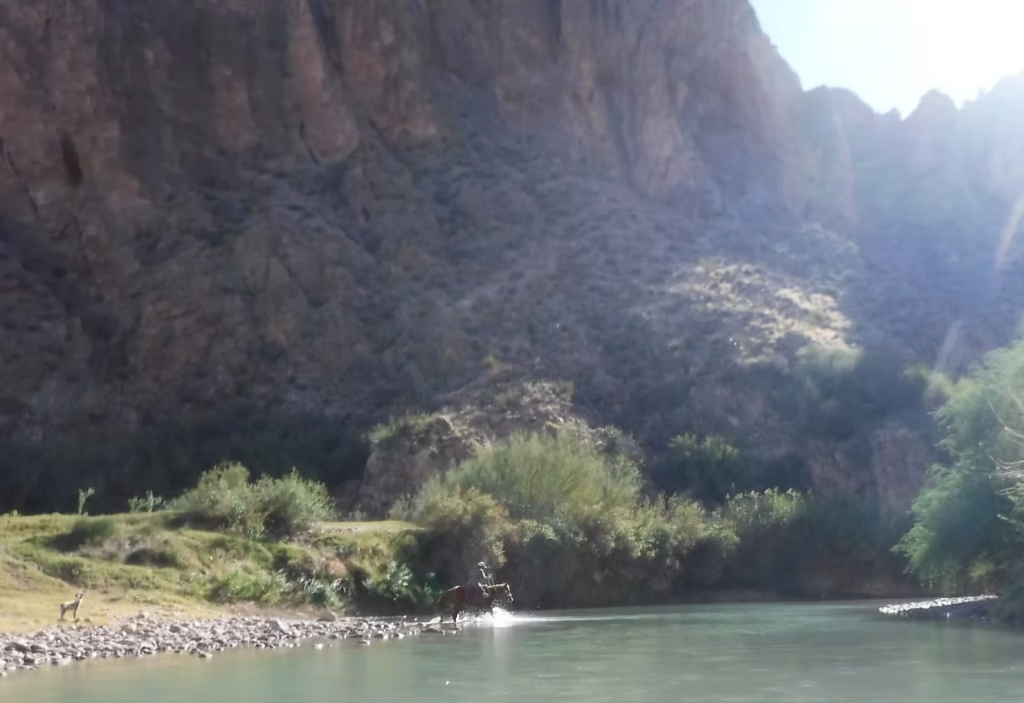
These vaquero’s have traveled the 30-odd miles down the canyon in a day,
and are returning to Boquillas with a small herd of cattle and horses.
After another few miles and some small rapids (one over bedrock ledges about six inches high), we enter a long stretch lined with invasive cane lining the banks. Due to the low water and super-channelization, the river tends to shove us right into the cane. Tu dislikes this, so I often get out and drag the canoe, to keep Tu happy (its worth the effort, as Tu pays dividends in “good boy” behavior). We round a bend and see another exceptional campsite, this time on the US side of the river. We have an easy, low rock-bar to land on, and a high, sandy bank with a nice level place on top for our tent. We also see that there is a very old two-track trail leading to this spot. No one has come down this trail in a long time, and we find a lot of great firewood, including three ironwood logs, like our first camp had. About an hour later, the other two canoes pass. I hope they can find a campsite in this cane-choked section of river.
I am very tired today, so I sit and write while enjoying a glass of wine. Tu gets more raw rib bones, and two hamburgers. My dinner, like last night’s, is a package of instant cheese/noodles and a bag of frozen vegetables mixed in; seems my body wants carbs, not protein. After dinner, I make a fire. There is dry grass nearby so I am careful not to let it get too large.

Sound in the desert? It doesn’t exist at times. Unless we are camped near a riffle, nightfall can bring a silence that can be felt. It’s almost like a sensory deprivation tank, the lack of sound makes Tu’s soft snoring the only sound heard. No wind, no coyotes, nothing. Nearly freaky.
The next morning, we get our earliest start on the river, 9:30. Our usual mode is to wait two hours from sun-up so the temperature is tolerable, but 12-14 hours in a tent is too long. The river is going to be more challenging today, as we have two named rapids. We leave our camp and go about three-fourths of a mile when we see a small, still smoldering campfire on a rocky bank on the Mexican side. Seems the two canoes made it this far and have left not long ago. Soon, we see them up ahead, apparently waiting for us to arrive. They are eyeballing Arroyo el Veinte, a twisty bit of fast water having canoe-wrapping capability. Tu and I say hello as we pull up to the “catch” and step out into calf-high water. I commend the group for not trying to run this (I would have run it, had they not been there, but I wanted to show these folks how to walk their canoes through, as the day prior they gave me a curious look when I mentioned lining a canoe.) I walked the Tripper to the edge of the deep water as Tu took it all in stride.
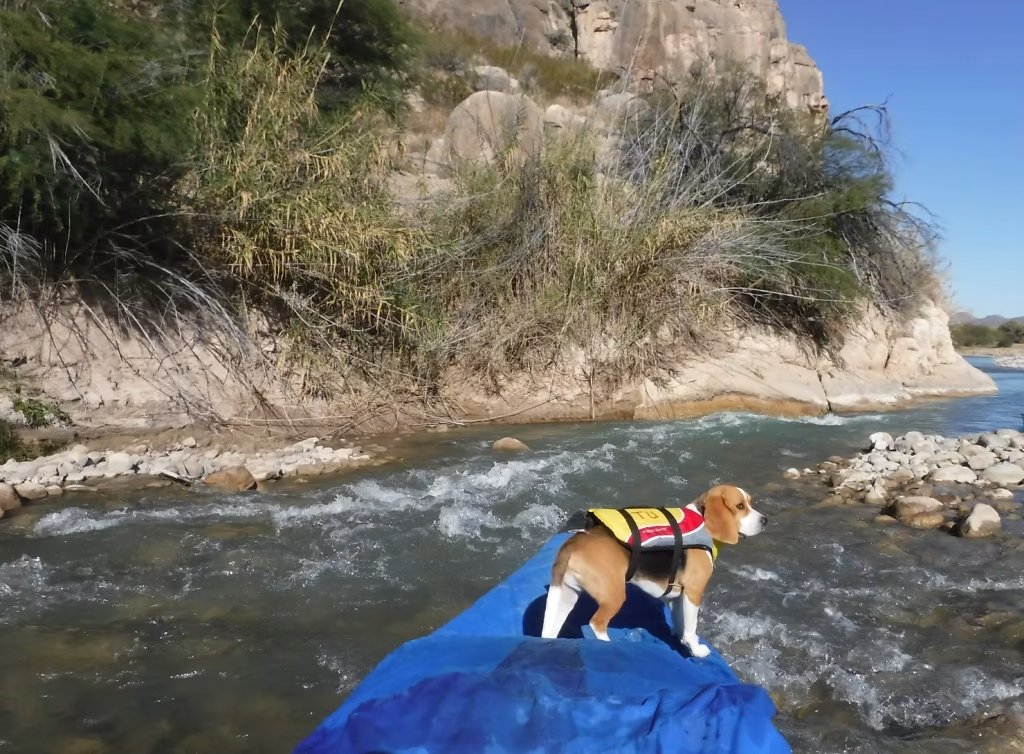
We have about a mile to go to get to the next and final rapid at the 778.5 mile mark. I wish I’d stopped for a pic of this rocky canoe-wrapping rock, but lined the canoe instead, while Tu sat calmly.
Eventually, we reach the eastern exit of Boquillas Canyon, and enter the flats. Despite being in a flat surrounding, the river picks up a little speed, going as fast as two mph in places, and zero in some long pools.
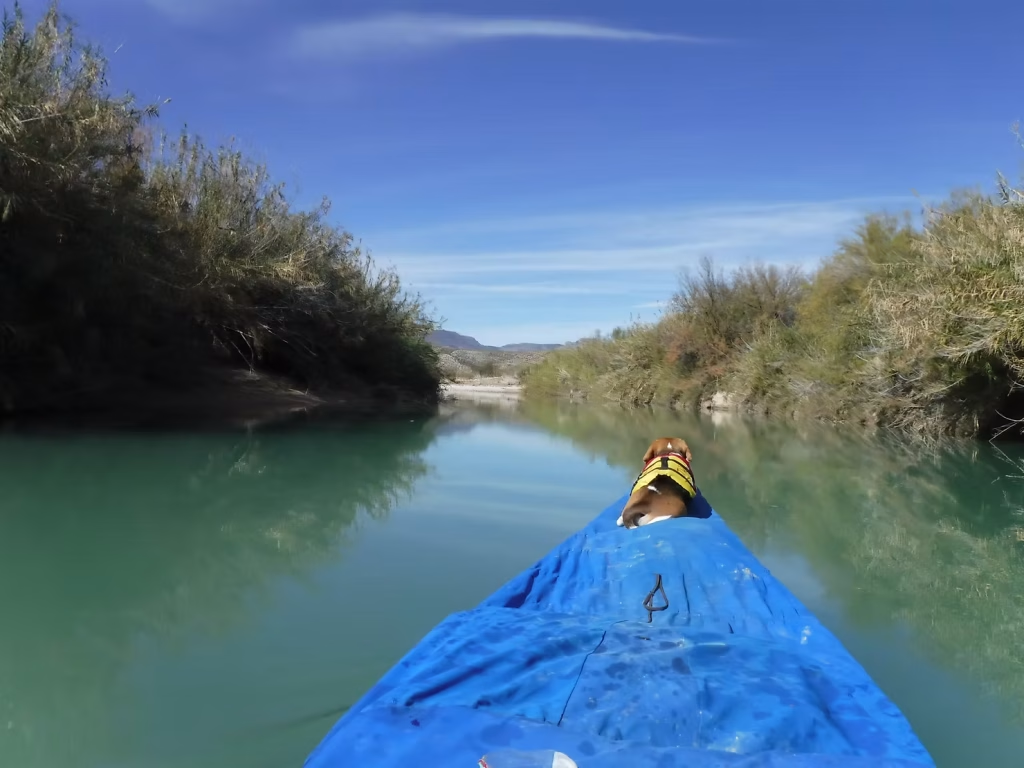
The last few miles are cane-lined, with occasional breaks of open desert grassland.
I want to say “All too soon, our trip was nearing its end.”, but we are right on time, as after packing up, we have a two hour drive back to Terlingua, where Butch and Rory Hancock play music with their band The Moonshiners, featuring Roger Moon on acoustic guitar and vocals, Mark Utter on dog-house bass, Rory on electric guitar and vocals, and Butch on harmonica.
The abandoned Mexican Dow-company village of La Linda is right below the old Gerstaker bridge, which soon comes into sight. Our take-out is the small beach about one-eighth of a mile below the bridge. Upon arrival, I pull the canoe up on the shore, then start the mile walk up to the Heath Canyon Ranch office, where we get our car. When we return, we see the shuttle van for the two canoes come into view. I won’t mention their outfitter’s name, as I don’t want to promote them, based on my conversation with the owner later that day, who had a client outlook of “They left their mommas a long time ago.” (Her words exactly), when I mentioned a brief pre-trip safety meeting for her obviously newbie paddling clients.
The very good and knowledgeable Outfitter and Guide service I recommend is Big Bend Boating and Hiking Co. hikingbigbend.com (469) 607-9869. I took a guided trip with them last year and saw the great care they had for their clients. For this trip, I relied on Erica and Erin for river info, which made me feel much more comfortable on this trip.
Oh, the Gerstaker bridge (named after the Dow Chemical Plant Manager) is the indicator that you are almost at the takeout:

Gestacker bridge ahead.
Tue has been atop my canoes since he was just weeks old and is very content here.
At campsite #1, I’d pulled the canoe up a five foot high, 45-degree rocky bank; when we were leaving, Tu jumped on top of the canoe before I could get it into the water. I asked him to get off for a moment, and he gave me a look of “Its OK, I got this,” so I pulled/pushed the canoe over the precipice, and the canoe quickly slid down. Then, just before the canoe was completely in the water, it got wiggly, as the tip of the stern was still on shore. Tu just braced his feet and took it all as big fun. Such a great canoe dog he is! Tu never fell in, even though there was plenty of opportunity.
This trip has been the single-most impressive multi-day trip I’ve ever been on, which includes the mighty White Cliffs of the Upper Missouri. Now, all I need to do is train myself and Tu more, so we can go down the Lower Canyons of the Rio Grande, a “no-joke” section of fast/technical water that is even more remote than Boquillas Canyon.
More on that “feeling of something bad is going to happen”: We all have crazy stuff going through or minds, such as “I wonder if polar bears get cold?”, or “Would a Martian like the color purple?”, or “I hope my 81 year old dad doesn’t die when I am out here.” I say a prayer regarding the last thought.”
After getting off the river, I try my cell phone, which says it won’t work as I’m outside the USA. The next morning, the phone decides to work, and I see that there is a flurry of messages; the first message went like “Tony, your dad is in the emergency room at the hospital, with high white and low red cell counts and has fluid filled lungs; they think he has pneumonia and won’t make it.” That message was from the day we put-on the river.
I went from the top of the world to the exact opposite in an instant.
Cell service was spotty, but I called each of the numbers that had called me…no answer; not good. I called dad’s closest friend, who also didn’t answer. I sunk lower. After 30 minutes or so, I received a text message from dad’s friend, letting me know that dad was out of the hospital and OK! Praise to God!!
With that, feeling extremely grateful, we start our way back home. That sense of worry? It’s gone.
Hope to see you on a river,
Tony & Tu
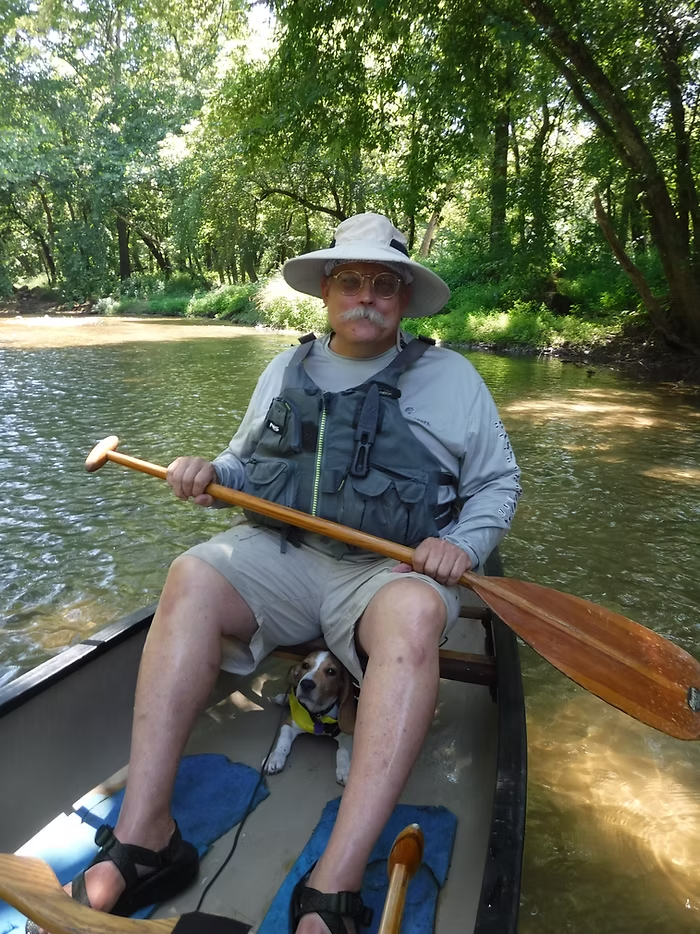
Tony and Tu… and Tony’s Sausage Smoker
****You may also enjoy my blog, Crisis on the Rio Grande (formerly titled, Been There, Done That!),which describes my experience on this river when it was dangerously high. Included, is an addendum (letter from a River Ranger) that tells the fate of the two men and the wrapped, red kayak.
*There are tips and procedures for canoeing the Rio Grande, and other desert rivers, in my flagship book, , CANOEING WILD RIVERS, 5th Edition.

